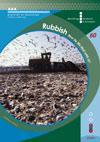You are here:
- Home »
- Teaching resources »
- Building Science Concepts »
- Titles and concept overviews »
- Rubbish: How Do We Deal with It?

Book 60: Rubbish: How Do We Deal with It?
Synopsis
- The properties of items we call "rubbish".
- Ways of sorting rubbish.
The context of rubbish is well known to children, and investigations into the ways in which we classify items as rubbish can begin with classroom and school contexts.
In grouping rubbish, its physical and chemical properties are explored (although no distinction need be drawn between these at this stage). In this way the activities provide the foundation for a stronger focus on recycling, which is covered in the companion level 3–4 book, Recycling, Book 61.
Concept overview
Use the concept overview, which is also on the inside front cover of the book, as a reference for the concepts that relate to Rubbish: How Do We Deal with It? and to the level 3–4 companion book, Recycling: New Uses for Rubbish , Book 61.
![]() Read the concept overview
(PDF 32 KB)
Read the concept overview
(PDF 32 KB)
Links with other titles in the series
- Book 5: Fur, Feathers, and Bark (L1–4, Living World)
- Book 23: Fresh Food (L1–2, Living World)
- Book 32: Introducing Metals (L1–2, Material World)
- Book 15: Where's the Water? (L1–2, Material World, Physical World, Planet Earth and Beyond)
- Book 48: Fabrics (L1–4, Material World)
This book has a focus on solid and liquid forms of rubbish, whose properties are more easily observed by children. Gaseous "rubbish", such as air pollutants, is beyond the scope of this book but is referred to in the books on the water cycle ( Water and Weather, Book 31 ) and air ( The Air around Us, Book 30 ), and solar energy ( Solar Energy, Book 29 ).
Assessment resources
Search the science section of the Assessment Resource Banks (ARB) website to find resources that assess the 'big idea' learning outcomes referred to in the concept overview for this title.

